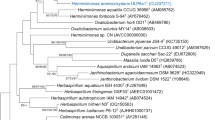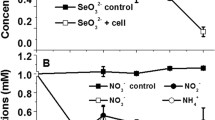Abstract
Rhodococcus erythropolis S43 is an arsenic-tolerant actinobacterium isolated from an arsenic contaminated soil. It has been shown to produce siderophores when exposed to iron-depleting conditions. In this work, strain S43 was shown to have the putative heterobactin production cluster htbABCDEFGHIJ(K). To induce siderophore production, the strain was cultured in iron-depleted medium in presence and absence of sodium arsenite. The metabolites produced by S43 in the colorimetric CAS and As-mCAS assays, respectively, showed iron- and arsenic-binding properties reaching a chelating activity equivalent to 1.6 mM of desferroxamine B in the supernatant of the culture without arsenite. By solid-phase extraction and two subsequent HPLC separations from both cultures, several fractions were obtained, which contained CAS and As-mCAS activity and which were submitted to LC-MS analyses including fragmentation of the major peaks. The mixed-type siderophore heterobactin B occurred in all analyzed fractions, and the mass of the “Carrano heterobactin A” was detected as well. In addition, generation of a molecular network based on fragment spectra revealed the occurrence of several other compounds with heterobactin-like structures, among them a heterobactin B variant with an additional CH2O moiety. 1H NMR analyses obtained for preparations from the first HPLC step showed signals of heterobactin B and of “Carrano heterobactin A” with different relative amounts in all three samples. In summary, our results reveal that in R. erythropolis S43, a pool of heterobactin variants is responsible for the iron- and arsenic-binding activities.
Key points
• Several heterobactin variants are the arsenic-binding compounds in Rhodococcus erythropolis S43.
• Heterobactin B and the compound designated heterobactin A by Carrano are of importance.
• In addition, other heterobactins with ornithine in the backbone exist, e.g., the new heterobactin C.







Similar content being viewed by others
References
Alexander DB, Zuberer DA (1991) Use of chrome azurol S reagents to evaluate siderophore production by rhizosphere bacteria. Biol Fertil Soils 12:39–45. https://doi.org/10.1007/BF00369386
Bergeron RJ, Singh S, Bharti N (2011) Synthesis of heterobactins A and B and Nocardia heterobactin. Tetrahedron 67(18):3163–3169. https://doi.org/10.1016/j.tet.2011.03.003
Blin K, Wolf T, Chevrette MG, Lu X, Schwalen CJ, Kautsar SA, Suarez Duran HG, de Los Santos ELC, Kim HU, Nave M, Dickschat JS, Mitchell DA, Shelest E, Breitling R, Takano E, Lee SY, Weber T, Medema MH (2017) antiSMASH 4.0-improvements in chemistry prediction and gene cluster boundary identification. Nucleic Acids Res 45(W1):W36–W41. https://doi.org/10.1093/nar/gkx319
Bosello M, Zeyadi M, Kraas FI, Linne U, Xie X, Marahiel MA (2013) Structural characterization of the heterobactin siderophores from Rhodococcus erythropolis PR4 and elucidation of their biosynthetic machinery. J Nat Prod 76(12):2282–2290. https://doi.org/10.1021/np4006579
Braud A, Geoffroy V, Hoegy F, Mislin GLA, Schalk IJ (2010) Presence of the siderophores pyoverdine and pyochelin in the extracellular medium reduces toxic metal accumulation in Pseudomonas aeruginosa and increases bacterial metal tolerance. Env Microbiol Rep 2(3):419–425. https://doi.org/10.1111/j.1758-2229.2009.00126.x
Braud A, Hannauer M, Mislin GLA, Schalk IJ (2009) The Pseudomonas aeruginosa pyochelin-iron uptake pathway and its metal specificity. J Bacteriol 191(11):3517–3525. https://doi.org/10.1128/JB.00010-09
Braud A, Hoegy F, Jezequel K, Lebeau T, Schalk IJ (2009) New insights into the metal specificity of the Pseudomonas aeruginosa pyoverdine-iron uptake pathway. Environ Microbiol 11(5):1079–1091. https://doi.org/10.1111/j.1462-2920.2008.01838.x
Carrano CJ, Jordan M, Drechsel H, Schmidt DG, Winkelmann G (2001) Heterobactins: a new class of siderophores from Rhodococcus erythropolis IGTS8 containing both hydroxamate and catecholate donor groups. BioMetals 14(2):119–125. https://doi.org/10.1023/A:1016633529461
Dimkpa CO, Merten D, Svatoš A, Büchel G, Kothe E (2009) Siderophores mediate reduced and increased uptake of cadmium by Streptomyces tendae F4 and sunflower (Helianthus annuus), respectively. J Appl Microbiol 107(5):1687–1696. https://doi.org/10.1111/j.1365-2672.2009.04355.x
Dimkpa C, Svatoš A, Merten D, Büchel G, Kothe E (2008) Hydroxamate siderophores produced by Streptomyces acidiscabies E13 bind nickel and promote growth in cowpea (Vigna unguiculata L.) under nickel stress. Can J Microbiol 54(3):163–172. https://doi.org/10.1139/w07-130
Drewniak L, Styczek A, Majder-Lopatka M, Sklodowska A (2008) Bacteria, hypertolerant to arsenic in the rocks of an ancient gold mine, and their potential role in dissemination of arsenic pollution. Environ Pollut 156(3):1069–1074. https://doi.org/10.1016/j.envpol.2008.04.019
Ghosh P, Rathinasabapathi B, Teplitski M, Ma LQ (2015) Bacterial ability in AsIII oxidation and AsV reduction: relation to arsenic tolerance, P uptake, and siderophore production. Chemosphere 138:995–1000. https://doi.org/10.1016/j.chemosphere.2014.12.046
Gomez-Caminero A, Howe P, Hughes M, Kenyon E, Lewis DR, Moore M, Ng J, Aitio A, Becking G (2001) Environmental health criteria 224 arsenic and arsenic compounds. Unit Nat Environment Prog. https://doi.org/NLM Classification: QV 294
Hofmann M, Retamal-Morales G, Tischler D (2020) Metal binding ability of microbial natural metal chelators and potential applications. Nat Prod Rep. 37:1262–1283. https://doi.org/10.1039/c9np00058e
Johnstone TC, Nolan EM (2015) Beyond iron: non-classical biological functions of bacterial siderophores. Dalton Trans 44(14):6320–6339. https://doi.org/10.1039/c4dt03559c
Jomova K, Jenisova Z, Feszterova M, Baros S, Liska J, Hudecova D, Rhodes C, Valko M (2011) Arsenic: toxicity, oxidative stress and human disease. J Appl Toxicol 31(2):95–107. https://doi.org/10.1002/jat.1649
Kem MP, Butler A (2015) Acyl peptidic siderophores: structures, biosyntheses and post-assembly modifications. Biometals 28:445–459. https://doi.org/10.1007/s10534-015-9827-y
Kraemer SM (2004) Iron oxide dissolution and solubility in the presence of siderophores. Aquat Sci 66(1):3–18
Kruger MC, Bertin PN, Heipieper HJ, Arsène-Ploetze F (2013) Bacterial metabolism of environmental arsenic-mechanisms and biotechnological applications. Appl Microbiol Biotechnol 97(9):3827–3841. https://doi.org/10.1007/s00027-003-0690-5
Mandal BK, Suzuki KT (2002) Arsenic around the world: a review. Talanta 58(1):201–235. https://doi.org/10.1016/S0039-9140(02)00268-0
Marshall G, Ferreccio C, Yuan Y, Bates MN, Steinmaus C, Selvin S, Liaw J, Smith A (2007) Fifty-year study of lung and bladder cancer mortality in Chile related to arsenic in drinking water. J Natl Cancer Inst 99(12):920–928. https://doi.org/10.1093/jnci/djm004
Miethke M, Marahiel MA (2007) Siderophore-based iron acquisition and pathogen control. Microbiol Mol Biol Rev 71(3):413–451. https://doi.org/10.1128/MMBR.00012-07
Mukai A, Komaki H, Takagi M, Shin-ya K (2009) Novel siderophore, JBIR-16, isolated from Nocardia tenerifensis NBRC 101015. J Antibiot 62:601–603. https://doi.org/10.1038/ja.2009.84
Nair A, Juwarkar AA, Singh SK (2007) Production and characterization of siderophores and its application in arsenic removal from contaminated soil. Water Air Soil Pollut 180(1–4):199–212. https://doi.org/10.1007/s11270-006-9263-2
Proença DN, Heine T, Senges CHR, Bandow JE, Morais PV, Tischler D (2019) Bacterial metabolites produced under iron limitation kill pinewood nematode and attract Caenorhabditis elegans. Front Microbiol 10:2166. https://doi.org/10.3389/fmicb.2019.02166
Renshaw JC, Robson GD, Trinci APJ, Wiebe MG, Livens FR, Collison D, Taylor RJ (2002) Fungal siderophores: structures, functions and applications. Mycol Res 106(10):1123–1142. https://doi.org/10.1017/S0953756202006548
Retamal-Morales G, Mehnert M, Schwabe R, Tischler D, Zapata C, Chávez R, Schlömann M, Levicán G (2018) Detection of arsenic-binding siderophores in arsenic-tolerating actinobacteria by a modified CAS assay. Ecotoxicol Environ Safe 157:176–181. https://doi.org/10.1016/j.ecoenv.2018.03.087
Ruttkies C, Schymanski EL, Wolf S, Hollender J, Neumann S (2016) MetFrag relaunched: incorporating strategies beyond in silico fragmentation. J Cheminform 8:3. https://doi.org/10.1186/s13321-016-0115-9
Schalk IJ, Hannauer M, Braud A (2011) New roles for bacterial siderophores in metal transport and tolerance. Environ Microbiol 13(11):2844–2854. https://doi.org/10.1111/j.1462-2920.2011.02556.x
Schwabe R, Anke MK, Szymańska K, Wiche O, Tischler D (2018) Analysis of desferrioxamine-like siderophores and their capability to selectively bind metals and metalloids: development of a robust analytical RP-HPLC method. Res Microbiol. 169(10):598–607. https://doi.org/10.1016/j.resmic.2018.08.002
Schwyn B, Neilands JB (1987) Universal chemical assay for the detection and determination of siderophores. Anal Biochem 160(1):47–56. https://doi.org/10.1016/0003-2697(87)90612-9
Senges CHR, Al-Dilaimi A, Marchbank DH, Wibberg D, Winkler A, Haltli B, Nowrousian M, Kalinowski J, Kerr RG, Bandow JE (2018) The secreted metabolome of Streptomyces chartreusis and implications for bacterial chemistry. Proc Natl Acad Sci USA 115(10):2490–2495. https://doi.org/10.1073/pnas.1715713115
Smith AH, Ercumen A, Yuan Y, Steinmaus CM (2009) Increased lung cancer risks are similar whether arsenic is ingested or inhaled. J Expo Sci Environ Epidemiol 19(4):343–348. https://doi.org/10.1038/jes.2008.73
Sultana M, Vogler S, Zargar K, Schmidt AC, Saltikov C, Seifert J, Schlömann M (2012) New clusters of arsenite oxidase and unusual bacterial groups in enrichments from arsenic-contaminated soil. Arch Microbiol 194:623–635. https://doi.org/10.1007/s00203-011-0777-7
Wang M, Carver JJ, Phelan VV, Sanchez LM, Garg N, Peng Y, Nguyen DD, Watrous J, Kapono CA, Luzzatto-Knaan T, Porto C, Bouslimani A, Melnik AV, Meehan MJ, Liu W-T, Crüsemann M, Boudreau PD, Esquenazi E, Sandoval-Calderón M, Kersten RD, Pace LA, Quinn RA, Duncan KR, Hsu C-C, Floros DJ, Gavilan RG, Kleigrewe K, Northen T, Dutton RJ, Parrot D, Carlson EE, Aigle B, Michelsen CF, Jelsbak L, Sohlenkamp C, Pevzner P, Edlund A, McLean J, Piel J, Murphy BT, Gerwick L, Liaw C-C, Yang Y-L, Humpf H-U, Maansson M, Keyzers R, Sims AC, Johnson AR, Sidebottom AM, Sedio BE, Klitgaard A, Larson CB, Boya CA, Torres-Mendoza D, Gonzalez DJ, Silva DB, Marques LM, Demarque DP, Pociute E, O’Neill EC, Briand E, Helfrich EJN, Granatosky EA, Glukhov E, Ryffel F, Houson H, Mohimani H, Kharbush JJ, Zeng Y, Vorholt JA, Kurita KL, Charusanti P, McPhail KL, Nielsen KF, Vuong L, Elfeki M, Traxler MF, Engene N, Koyama N, Vining OB, Baric R, Silva RR, Mascuch SJ, Tomasi S, Jenkins S, Macherla V, Hoffman T, Agarwal V, Williams PG, Dai J, Neupane R, Gurr J, Rodríguez AMC, Lamsa A, Zhang C, Dorrestein K, Duggan BM, Almaliti J, Allard P-M, Phapale P, Nothias L-F, Alexandrov T, Litaudon M, Wolfender J-L, Kyle JE, Metz TO, Peryea T, Nguyen D-T, VanLeer D, Shinn P, Ajit Jadhav A, Müller R, Waters KM, Shi W, Liu X, Zhang L, Knight R, Jensen PR, Palsson BO, Pogliano K, Linington RG, Gutiérrez M, Lopes NP, Gerwick WH, Moore BS, Dorrestein PC, Bandeira N (2016) Sharing and community curation of mass spectrometry data with Global Natural Products Social Molecular Networking. Nat Biotechnol 34(8):828–836. https://doi.org/10.1038/nbt.3597
Wichard T, Bellenger JP, Morel FMM, Kraepiel AML (2009) Role of the siderophore azotobactin in the bacterial acquisition of nitrogenase metal cofactors. Environ Sci and Technol 43(19):7218–7224. https://doi.org/10.1021/es8037214
Zeyadi MAM (2015) Structural characterization of the heterobactin siderophores from Rhodococcus erythropolis PR4 and elucidation of their biosynthetic machinery. Dissertation, Philipps-Universität Marburg, Germany
Acknowledgements
The authors thank Thomas Heine for providing access to the draft genome sequence of R. erythropolis S43 on the RAST server.
Data and materials availability
The authors declare that all other data supporting the findings of this study are available within the article and its supplementary information files.
Funding
This work was supported by project Fondecyt #1170799 from the government of Chile, and USA1799 and Dicyt-USACH from University of Santiago. GR-M has received a doctoral fellowship from CONICYT (COD: 21140962). A stay of GR-M in Freiberg was supported by the DAAD project YoungGEOMATENUM-International. The work of DT and MSt was supported by BMBF junior research group BakSolEx (#033R147). JEB acknowledges funding from the German Research Foundation (BA 4193/6-1) and thanks the German federal state of North Rhine-Westphalia for funding the mass spectrometer (Forschungsgroßgeräte der Länder).
Author information
Authors and Affiliations
Contributions
MSc and GL conceived and designed research. GR-M, MSe, MSt conducted experiments. JEB, DT, AO, and BM contributed new reagents or analytical tools. GR-M and CHRS analyzed data. GR-T, GL, and MSc wrote the manuscript. All authors read and approved the manuscript.
Corresponding authors
Ethics declarations
Ethical approval
This article does not contain any studies with human participants or animals performed by any of the authors.
Conflict of interest
The authors declare no competing interests.
Additional information
Publisher’s note
Springer Nature remains neutral with regard to jurisdictional claims in published maps and institutional affiliations.
Supplementary Information
ESM 1
(PDF 2958 kb)
Rights and permissions
About this article
Cite this article
Retamal-Morales, G., Senges, C.H.R., Stapf, M. et al. Isolation and characterization of arsenic-binding siderophores from Rhodococcus erythropolis S43: role of heterobactin B and other heterobactin variants. Appl Microbiol Biotechnol 105, 1731–1744 (2021). https://doi.org/10.1007/s00253-021-11123-2
Received:
Revised:
Accepted:
Published:
Issue Date:
DOI: https://doi.org/10.1007/s00253-021-11123-2




